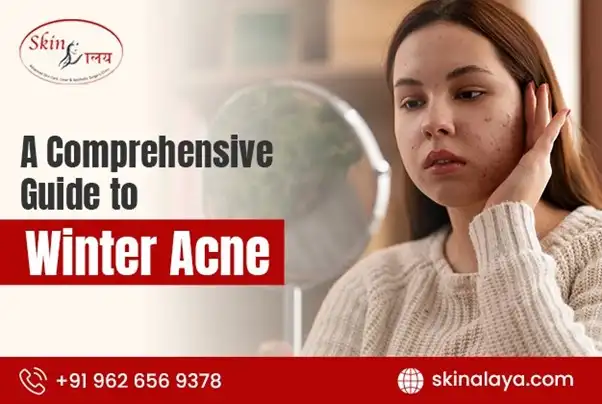
As winter blankets the world, many grapple with an unexpected adversary—winteracne. This seasonal skincare concern brings forth unique challenges, adversely affecting skin health. The drop in temperature and the arrival of dry, frigid airstrip our skin of its natural moisture, creating an environment ripe for acne development. The challenges are manifold, from increased dryness and dehydration to the aggravation of existing skin conditions. In this guide, we'll explore practical tips to safeguard your skin during the chilly months ahead, providing valuable insights for effective winter acne management.
Winter acne refers to the occurrence of acne breakouts during the winter season. Several factors contribute to this phenomenon. The cold and dry air in winter can strip the skin of its natural oils, leading to increased dryness. In response, the skin may produce more oil to compensate, potentially clogging pores and causing acne. Additionally, indoor heating systems can further contribute to dry skin.
People often experience changes in their skincare routines during winter, using heavier moisturizers or neglecting to stay adequately hydrated. These changes can affect the balance of the skin, making it more prone to breakouts.
Moreover, individuals may be tempted to take hot showers in the winter, but hot water can strip the skin of its natural moisture, exacerbating the issue. To manage winter acne, it's essential to maintain a consistent skincare routine, stay hydrated, and adapt skincare practices to the season's unique challenges.
Winter acne is most prevalent during the colder months, typically from late fall to early spring. The combination of cold, dry air and indoor heating systems creates an environment that can be harsh on the skin. This period sees a rise in factors contributing to acne breakouts, such as increased dryness, excess oil production, and potential changes in skincare habits.
The transition from warmer to colder temperatures is a critical time for skin adaptation, and if not managed properly, it can lead to an uptick in acne. Additionally, during winter, individuals may be exposed to fluctuating temperatures as they move between cold outdoor air and heated indoor environments, further stressing the skin and contributing to acne issues.
During the winter, acne can manifest on various parts of the body due to a combination of environmental factors and changes in skincare habits. Common areas affected include:
To manage and prevent winter acne on these body parts, maintaining a consistent and appropriate skincare routine, staying hydrated, and adapting clothing choices to minimize irritation are essential measures.
As the winter chill sets in, adopting proactive measures becomes crucial to prevent and treat the pesky issue of winter acne. Let's explore practical tips for maintaining clear and healthy skin during the colder months.
By incorporating these practices into your winter skincare routine, you can minimize the risk of acne breakouts and maintain healthy skin throughout the colder months.
If your efforts to manage winter acne using over-the-counter products prove ineffective, it's advisable to consult a dermatologist. Seek professional assistance if:
A dermatologist can provide a tailored dermatologist care treatment plan, addressing specific winter-related skin challenges.
In summary, effectively managing winter acne involves grasping its challenges, such as dry air and indoor heating. Prioritize proactive winter skin care by focusing on hydration and adjusting routines for seasonal variations. The key lies in consistent efforts to preserve skin health. If challenges persist, consider consulting a professional for personalized guidance. Ensure your skin receives the skin care treatment it deserves, promoting a clear and radiant complexion throughout the winter season.
